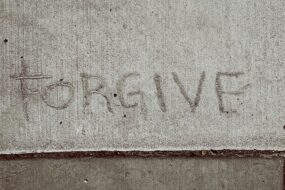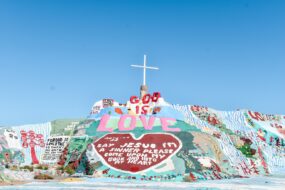April 11, 2020 • Life for Leaders
If Christ has not been raised, your faith is futile and you are still in your sins. Then those also who have died in Christ have perished. If for this life only we have hoped in Christ, we are of all people most to be pitied. But in fact Christ has been raised from the dead, the first fruits of those who have died.
1 Corinthians 15:17-20 (NRSV)
Today is Holy Saturday. It is the day after Good Friday, when we remember the death of Christ on the cross, and the day before Easter, when we celebrate the resurrection. Holy Saturday is a day in-between.
Some Christians have rich traditions for Holy Saturday, using it as a special time to gather for prayer and worship. For most of my life, it was simply the Saturday before Easter, a time to dye Easter eggs and get ready for Sunday’s celebrations. In recent years, however, I have found Holy Saturday to be a particularly important time for my own quiet reflection.
For a couple of decades now, my thoughts have been inspired by a memory of something my daughter, Kara, said on Holy Saturday when she was about four years old. As we sat down for our family dinner, I asked my son, Nathan, to pray for our meal. He began, “Dear Jesus . . . .” Immediately Kara interrupted him with an incensed tone in her loud voice. “Nathan, you can’t pray to Jesus tonight. He’s dead!” Nathan, with a more mature six-year-old theology, responded, “Yes, I can pray to Jesus. He’s not really dead anymore. That was a long time ago.” But Kara was insistent. Jesus was dead. He died on Friday. We couldn’t pray to him until Sunday, after he rose from the dead.
Though I agree with Nathan’s theology, I must say there’s something about Kara’s experience that I appreciate. For her, the death of Jesus was utterly, literally real. He was truly, as they say, “dead and gone.” Because of her developmental stage, she had the opportunity to enter into the experience of Jesus’s death much like his own disciples. The day after Jesus died, they also believed he was dead and gone . . . forever.
What would it have been like to believe that Jesus was dead, fully and forever? Beyond the personal despair associated with losing a loved one, and beyond the horrible memories of Jesus’s crucifixion, the disciples would also have lost hope and faith. Jesus had proclaimed the coming of God’s kingdom—with its healing, justice, forgiveness, and love. But, for the disciples, Jesus’s proclamation had died on the cross along with him. A couple of decades later, the Apostle Paul explains what this would have been like for the disciples: “If Christ has not been raised, your faith is futile and you are still in your sins. . . . If for this life only we have hoped in Christ, we are of all people most to be pitied” (1 Corinthians 15:17,19). Holy Saturday gives us an opportunity to reflect on what life would be like if Christ had not been raised.
Why set aside time to think about this dreary possibility? Because our reflection on a resurrection-less reality prepares us for a deeper and truer celebration of Easter and its extraordinary good news. Christian faith rests, not on wishful thinking, not on good intentions, not on happy feelings, but on the truth that Jesus rose from the dead on Easter. As Paul writes in the next verse from our passage in 1 Corinthians: “But in fact Christ has been raised from the dead” (15:20). Sometimes we can rush right by this good news without letting it penetrate our hearts or change our lives. But if we reflect on what we would be like without the resurrection, then the fact that Christ has been raised from the dead becomes not simply an article of faith, but an essential and glorious truth that transforms our lives—and, ultimately, not just our individual lives, but the whole creation (see Ephesians 1:10).
So, on this Holy Saturday, though you’re certainly welcome to pray to Jesus, let me invite you to reflect with me on the meaning of his death and resurrection. Let your consideration of what life would be like without the resurrection prepare your heart for a joyous and life-changing celebration tomorrow.
Something to Think About:
Do you have any personal or family traditions associated with the Saturday before Easter? If so, what do these mean to you?
How might your life be different if Jesus had not been raised from the dead?
Something to Do:
 Set aside some time today to reflect on what your life – and all of life – would be like if Jesus had not been raised from the dead. Talk to God the Father about this (or Jesus, if you like!).
Set aside some time today to reflect on what your life – and all of life – would be like if Jesus had not been raised from the dead. Talk to God the Father about this (or Jesus, if you like!).
Prayer:
Gracious God, I confess that I can easily take for granted the resurrection. When I do, I fail to comprehend the wonder of your grace and power in raising Jesus from the dead and how much this means to me. Yet, when I imagine what life would be apart from the resurrection, I shudder. As Paul said, my faith would be futile. I would still be in my sins. And I would have no lasting hope.
I do know where this story is going next, Lord. But, on this Holy Saturday, meet me as I reflect on the meaning of the cross and resurrection. Prepare me, I pray, to experience the joyful good news of Easter in a deeper and truer way tomorrow. Amen.
You can access all of our Life for Leaders devotions here.
Explore today’s passage in more depth at the Theology of Work Project online commentary: Our Work Is Not In Vain (1 Corinthians 15:18)

Dr. Mark D. Roberts is a Senior Strategist for Fuller’s Max De Pree Center for Leadership, where he focuses on the spiritual development and thriving of leaders. He is the principal writer of the daily devotional, Life for Leaders, and the founder of the De Pree Center’s Flourishing in the Third Third of Life Initiative. Previously, Mark was the Executive Director of the De Pree Center, the lead pastor of a church in Southern California, and the Senior Director of Laity Lodge in Texas. He has written eight books, dozens of articles, and over 2,500 devotions that help people discover the difference God makes in their daily life and leadership. With a Ph.D. in New Testament from Harvard, Mark teaches at Fuller Seminary, most recently in his D.Min. cohort on “Faith, Work, Economics, and Vocation.” Mark is married to Linda, a marriage and family counselor, spiritual director, and executive coach. Their two grown children are educators on the high school and college level.





Holy Saturday has become one of my favorite days. Besides being the final day of Lent, it’s a vigil. It’s waiting, just as Jesus’ friends, family, and followers waited to be able to bury Him properly. But we wait with hope, for we know what (or rather Whom) we are waiting for.
In my Anglican tradition, the Holy Saturday Vigil is my favorite service. Some parts of it are from the sixth century, similar to the Solemn Collects of the Good Friday service. But my favorite part, a part we cannot celebrate because of social distancing, is that this service, this vigil, starts outside the church just after sunset. The priest uses flint and stone to light the Easter Fire, with which he lights the Paschal candle, a large white candle with red wax figures on its side for the year, the Greek letters of Alpha and Omega, and a large cross. Once the Paschal candle is lit, the congregation, holding unlit candles, processes behind the priest toward the darkened church. Three times: at the doors of the church, at the beginning of the pews, and again near the front of the church, the priest sings in plainsong: “The Light of Christ!” and the congregation responds, also in plainsong, “Thanks be to God!” and from the Paschal candle, the candle of the acolyte is lit, and from there everyone lights candles until a third of the congregation’s candles are lit. Thus, at the end of the third declaration, the whole congregation has their candles lit. We bring the light of Christ into the unlit church, the unlit world, if you will, a light spread from Christ and then from His people, one to another. It’s a beautiful picture of Christ’s light and love pushing back the darkness and being shared from believer to believer. And then the liturgy begins in which we read several Scriptures and end up with reaffirming our baptismal vows and then singing the first Evensong of Easter.
We are still holding our vigil tonight on Zoom, but it still won’t be the same. We are to have candles ready to light on our own. But this amazing service, so ancient and so, so relevant, holds and expresses all of the anticipation of forty days of fasting, waiting, and hoping for the JOY of the Resurrection.
He is risen! He is risen, indeed! Alleluia!!
Soli Deo Gloria,
Susanne 🙂